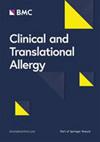Improving Diagnostic Accuracy in Respiratory Allergy: Monocentric Reevaluation of the GA2LEN Panel in Germany
Abstract
Background
European guidelines recommend using a standardized baseline series of skin prick test (SPT) allergens for the diagnosis of airway allergies. In addition, local adaptation and/or extension of test panels according to regional exposure and sensitization patterns are increasingly being discussed.
Methods
Regional sensitization rates according to SPTs based on the most recent GA2LEN baseline series in Central Germany were retrospectively analyzed for 960 consecutive patients with respiratory symptoms at our university outpatient clinic. Additional SPT allergens of interest were further analyzed.
Results
High sensitization rates to the baseline SPT series were observed in our highly selected study cohort. The positivity rates were particularly high for olive pollen (30.8%) and plantain pollen (33.4%). Positive olive and birch pollen SPTs were found in 98.5% of olive-ash-birch pollen tested patients. High SPT positivity rates (98.1%) for plane tree and olive tree pollen were found, whereas only six patients (1.9%) were diagnosed with exclusive cypress pollen sensitization. Subgroup analysis of SPTs for palm tree pollen revealed that 92% of patients with palm tree positivity showed polysensitization, and all but one patient had concomitant grass pollen sensitization.
Conclusion
Regular evaluations of SPT series may be necessary because of climate change, extract production, and increasing population mobility. Ash and cypress pollen extracts could currently be removed from the baseline SPT panel without significantly decreasing diagnostic accuracy. Positive SPTs to non-native palm tree pollen may indicate the presence of IgE to cross-reacting panallergens, which may help to differentiate primary sensitization from cross-reactivity directly. Limitations include the retrospective monocentric design and lack of molecular IgE confirmation.


 求助内容:
求助内容: 应助结果提醒方式:
应助结果提醒方式:


